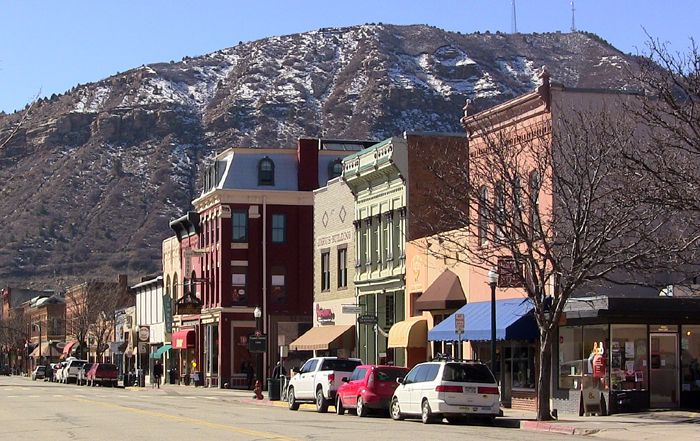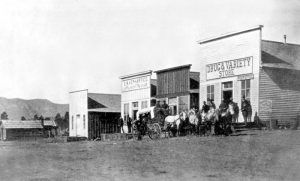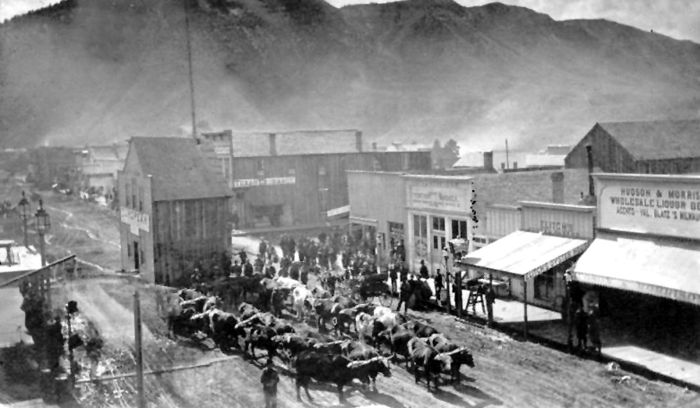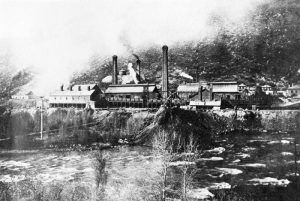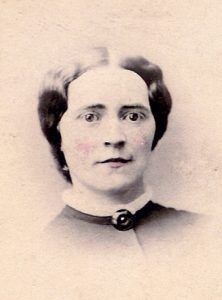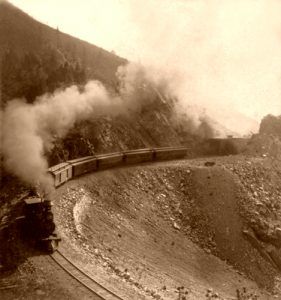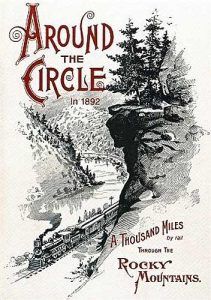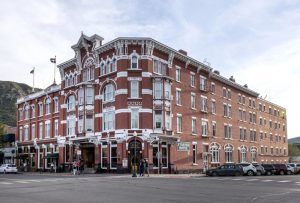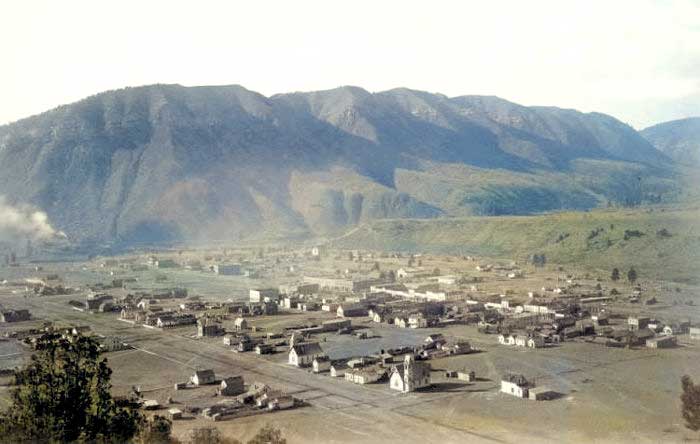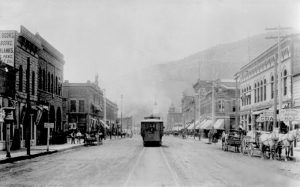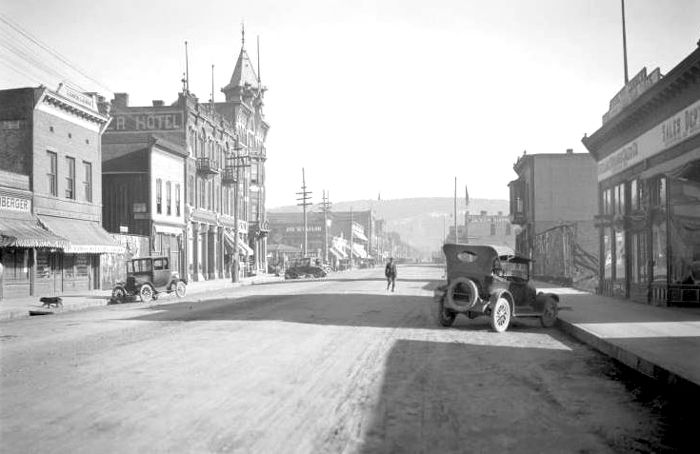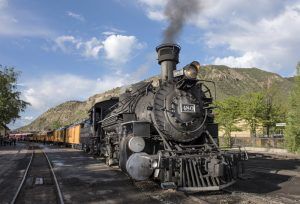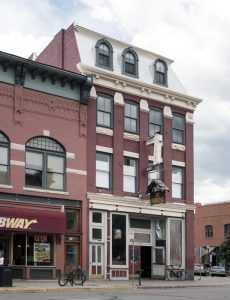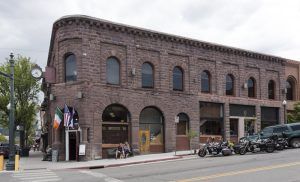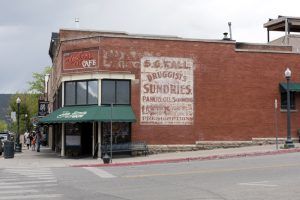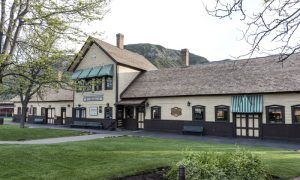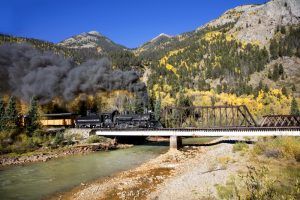Durango, Colorado, located along the Million Dollar Highway, is the county seat of La Plata County and the most populous town in southwest Colorado.
This area was once the home of the Ancestral Puebloans for centuries before the Ute Indians made this land their territory. Miners began to make their way into the area in the 1860s but were pushed out by the Ute Indians until a treaty was made with the tribe in 1873, and they were placed on a reservation.
A town called Animas City was established in the area by miners and ranchers in 1876. It soon became a trade center and had 286 residents. It was also home to Camp Animas, which housed cavalry and infantry troops.
However, when the Denver & Rio Grande Railway was looking to build through, the company couldn’t agree with the town and chose another site a few miles to the south along the banks of the Animas River.
As the Denver & Rio Grande Railway was building westward, a group of investors, General William J. Palmer, president of the railroad, along with William A. Bell and John A. Porter formed the Durango Trust to buy and sell property and establish the townsite. Its name was chosen by Colorado’s former territorial governor A. C. Hunt, who thought the area looked similar to that of Durango, Mexico.
Durango was surveyed and platted in September 1880. Lots were offered for $50 to $100, and in the first two days, buyers snapped up over $15,000 in parcels. At that time, many of the businesses, including the newspaper and the bank, moved from Animas City to the new town of Durango. That year, William Bell bought 160 acres for $500 and donated land for a school and a city hall. William Palmer also donated land for the city to use. At the same time, John A. Porter began building a smelter for the New York and San Juan Mining and Smelting Company, another firm that Palmer and Bell figured prominently. The smelter was located immediately west of the Durango townsite, on the west bank of the Animas River, and at the foot of what was soon called Smelter Mountain. In addition to the smelting works, Palmer and his associates purchased a limestone quarry and several nearby coal mines. By Christmas, Durango already boasted 200 residents along with numerous houses and businesses.
A post office opened on January 3, 1881, and by April, the smelter was up and running. It was successful partially due to the coal available in the area. The Denver and Rio Grande’s line from the east arrived in Durango from Alamosa in August 1881. A huge celebration was held on August 5th, and the governor arrived to participate in the ceremonies, which included a parade, a free barbecue, races, and other activities.
In the meantime, hundreds of people had arrived in the new town to work in the smelter, mines, and on the railroad. Within a year of its founding, Durango had a population of 2,400, and the city had already become the commercial center of the Southwest. It also became the supply point for nearby Fort Lewis, located about 2 miles to the west. By that time, the town boasted 134 businesses, including at least 20 saloons.
In the fall of 1881, tracklaying north of Durango began, and in November, voters chose to move the La Plata County seat from Parrot City to Durango.
The Episcopalian Church responded first to an offer of free land from the Durango Trust to be the first church to build in town. It opened in 1881 and was quickly followed by the Methodist, Presbyterian, Baptist, and Catholic churches. The same year, the Durango School District was formed.
A woman named Caroline Romney published Durango’s first newspaper using a small used printing press. The first issue of the weekly Durango Herald was produced in a tent on December 29, 1880. Romney had worked as a correspondent for the Chicago Times and was a widow by the time she made her way to Durango. In January 1881, the newspaper moved to a building on 2nd Avenue and began issuing a 7-column daily newspaper.
Romney became unpopular when she started reporting on the activities of several outlaws who formed the Stockton/Eskridge Gang, who had been rustling cattle and jumping claims across the state line in New Mexico. The gang would then retreat into southwest Colorado, where they flaunted themselves as wealthy cattlemen and opened a butcher shop in Animas City. Port Stockton had even served as the Animas City marshal. After the gang murdered a man from Farmington, New Mexico, several Farmington cowboys rode up to Durango to get revenge for his murder in April 1881. This resulted in shots being fired between the two factions, and eventually, the Stockton/Eskridge Gang was run out of town.
The Durango Herald, described as “a straight-out Republican newspaper,” purchased the Durango Record in 1882, and by the next year, Caroline Romney moved on to run a newspaper in Trinidad, Colorado.
In the meantime, the Denver & Rio Grande Railroad had continued grading and tracklaying, and on July 8, 1882, the first passenger train followed the tracklayers into Silverton. In that year, the “Silvery San Juan” produced $20,000,000 worth of ore. In 1885, Durango had a population of 2,254 residents, while Animas City had shrunk to 83. The last rail had barely been laid in Silverton in 1882 when promoters began inviting tourists to enjoy the scenery and culture of the region.
In 1887, the Strater Hotel was built by a young man named Henry Strater, a pharmacist. With help from his family, the four-story brick hotel was built at the cost of $70,000 and opened the next year. Henry Strater didn’t run the property but leased it to H.L. Rice, and under his management, the hotel soon became known as “the place” of social gathering. Strater’s occupied a small part of the building. Today, the Victorian Strater Hotel continues to serve guests and is a prominent downtown landmark, located just two blocks north of the Durango & Silverton Narrow Gauge Railroad.
Also occurring in 1887 was the construction of an electric power plant that delivered electricity to homes and businesses. Durango was the earliest city in the county to have electrical power. By that time, the Durango Smelter processed one million pounds of silver, lead, gold, and copper and was one of the area’s largest employers, with 300 men working.
In 1889, a disastrous fire broke out downtown, damaging several blocks along Main Avenue. Afterward, the City Council made an ordinance that new buildings must be constructed with stone and brick.
By the early 1890s, Durango was really promoting tourism. The Durango Board of Trade, a local booster organization, published a promotional brochure in 1892 touting all that Durango had to offer, suggesting that visitors could tour the smelter and coal mines, see the Indians both in Durango and out on their reservation, ride the Rio Grande Southern to a point close to the Mesa Verde Cliff Dwellings, and enjoy outdoor activities such as camping, hunting, and fishing.
The railroads also promoted the area. Combined with the Rio Grande Southern Railroad, the Denver & Rio Grande promoted the “Around the Circle Tour,” which provided a four-day 1,000-mile loop through scenic southwestern Colorado for just $28.
By this time, the town boasted four banks, two flour mills, the Durango Iron Works, two brick companies, and the smelter company reported healthy capitalizations and 2796 people in 1900.
In 1892 the St. Columba Catholic Church, school, and Mercy Hospital were started by the Sisters of Mercy. The hospital was first situated in a frame building with eight beds. A more substantial stone building replaced the first one in 1894. At that time, Mercy was the only general hospital in southwestern Colorado. Today, the church and school are still at their original site on North Main Avenue, but the Mercy Regional Hospital moved to the Grand View area of La Plata County.
In 1893, Henry Strater, who had neglected to exclude his pharmacy location in the lease of the Strater Hotel to H.L. Rice. Rice became extremely frustrated with the high rent. As a result, he determined to build the three-story Columbian Hotel directly next door with the intent of putting Rice out of business. Unfortunately, for Strater and the rest of the area, the Silver Crash occurred the same year. Both hotels continued to operate until 1895, when both were foreclosed on. Afterward, the Columbian Hotel was consolidated with the Strater Hotel.
Several social organizations formed early on, including the Durango Archaeological and Historical Society in 1893, the social Durango Club, various labor organizations, a gun club, a baseball club, two Chautauqua Clubs (adult education movement), a Shakespeare Circle, and various reading clubs. The granges, rural schoolhouses, and dance halls provided social gathering places in the rural areas. Two opera houses opened in 1894 and 1895, offering alternative entertainment to the many saloons, gambling dens, and dance halls in Durango.
Durango had a telephone system supporting 66 phones by 1894.
In 1896, the Durango Suburban and Street Railway began to operate, originally drawn by horses or mules, and only went from the train depot north to the Animas River. Later, it was electrified and traveled all along Main Avenue in Durango and Animas City. It continued to operate until 1921.
At the turn-of-the-century, most of the area mines had played out, and Durango’s economy became more diversified, focused on timber harvesting, ranching, farming, and tourism. The creation of the San Juan National Forest in 1905 and Mesa Verde National Park in 1906 brought more tourists to the area.
Throughout the course of many years, the Denver & Rio Grande Western Railroad carried over three hundred million dollars in precious metals. By the beginning of the 20th century, the region’s railroad system faced many challenges; slides, floods, snow, war, and financial instability. When the US Government entered World War I, it assumed operation of the railroads for a time.
In 1910, the town had a population of 4,686. In October 1911, Durango and much of the area suffered a devastating flood. Described as the worst flooding in southwestern Colorado’s history, it destroyed more than 100 bridges, 300 miles of railroad tracks, destroyed crops in the Animas Valley, and resulted in several deaths. Causing an estimated $1.5 million in damage across the region, all telegraph and telephone communications were lost, and Durango and Silverton were cut off from the rest of the world. The most immediate concern at the time was food and fuel shortages for the 3,000 residents living in Silverton with winter coming on. Fortunately, partial road and railroad routes to the north were restored within a week or two, though most of the travel was via burro and horse-drawn wagon.
Over the next decade, the Durango area had to become accustomed to automobile travel. Locals responded by building several auto courts and motels in La Plata County, mostly in Durango. In 1924, the Colorado Department of Transportation completed the Million Dollar Highway (US Highway 550) to Durango.
During the Great Depression years, the Durango area suffered many of the same economic hardships facing the rest of the country.
During World War II, mining picked up again, and in the 1950s, uranium was the sought-after ore. At that time, the Durango Smelter was refitted for the processing of uranium ore. Oil and gas were also discovered. In 1948 Animas City, which had a population of about 500 people, was annexed to Durango. Today, the location of what was once Animas City is called Uptown Main.
In 1956, Fort Lewis College was moved from south of Hesperus to Durango and changed from a two-year agricultural school to a four-year liberal arts curriculum. A new community hospital district was also built, providing an alternative to Mercy Hospital, which also expanded and remodeled in the 1950s.
In 1966 the Purgatory Ski resort was developed north of Durango.
Today, Durango’s population is about 18,500. Though it has all the amenities of a small city, tourism continues to be an important aspect of Durango’s economy.
The Durango & Silverton Narrow Gauge Railroad is one of the most popular attractions, running through the mountainsides along the Animas River Valley to Silverton.
Durango’s architectural heritage is visible along the Main Avenue Historic District, which consists of 104 commercial buildings that collectively reflect the late 19th and early 20th-century history and architecture of the downtown area. The 34-acre area was listed on the National Register of Historic Places in 1980.
A few of the more interesting buildings include:
The Newman Building at 801 Main was built in 1892 by Colorado businessman and politician Charles Newman who had made his fortune opening drugstores in Animas City, Silverton, and Chama and locating the Swansea Mine near Rico in the late 1870s. The first tenant was the Smelter National Bank, which closed in 1897. The imposing building that firmly lays claim to the corner has been carefully restored on both the exterior and interior and is listed in the National Register of Historic Places. Today, it is the fanciest office building in Durango.
The First National Bank building, located at 901 Main, an elaborately detailed Queen Anne brickwork building with Romanesque sandstone arched windows, was built for $18,219 and replaced an earlier frame building that burned in 1892. The First National Bank moved south from Animas City in 1881 and operated in Durango from 1882 until 1980.
The Palace Hotel Building at #1 Depot Place was built in 1895. The two-story painted brick structure has housed the Palace Restaurant for 40 years. The restaurant retains the elegant character of the late 19th century Western architecture and design.
The General Palmer Hotel at 561-67 Main was built in 1902 by William Jackson Palmer, the president of the Denver & Rio Grande Railroad. The two-story painted brick structure is located right next to the railroad depot. The building has always served as a hotel and had never closed.
The La Plata Bottling Works and Saloon at 645 Main was built in 1900 as a bottling works for the Adolph Coors Company, which owned the building until 1915. It was then taken over as the La Plata Bottling Works and Saloon. John Kellenberger, Durango’s first Coca-Cola franchisee, purchased the operation during Prohibition. This brick bearing wall structure is relatively unadorned except for a tall sheet metal parapet with large brackets at either end and a gable above the letters “A. COORS A.D. 1900” in relief. Its 25-foot frontage with three bays at the second level is characteristic of many older intermediate row buildings that remain along Main Street.
The Strater Hotel at 699 Main was built in 1888 and exemplified the period of wealth from the mines, railroad, and smelter. At that time, Durango was ripe for an elegant hotel, and Henry Strater answered the call. The building is an eclectic mix of Italianate, Romanesque, and Renaissance architectural styles. It was immediately leased to H.L. Rice and after the relationship between he and Strater soured, Strater built the new Columbian Hotel immediately next door. The two hotels are now one establishment, and it continues to serve guests. The building is also home to the Durango Opera House with seating for 100- 200 people.
The Gardenswartz Building, located at 863-871 Main, was built in 1901. This was the showpiece of the Denver & Rio Grande Railroad’s land development company and was intended to be a model for future buildings. Today, the original storefront openings at the street level on the southern half of the building are largely intact while unsympathetic remodeling has obscured the northern portion’s lower level.
The Central Hotel building at 975 Main is a four-story French Second Empire structure built in 1892. Over the years, it housed a saloon, a post office, a bank, and a hotel. References to French culture were often included in Victorian commercial architecture as an allusion to the continental sophistication associated with the French. On the first floor, today is the El Rancho Tavern, where 20-year-old future heavyweight boxing champion Jack Dempsey’s victory over Andy Malloy across the street at the now-long-demolished Gem Theater is remembered in a mural on an outside wall.
The Burns Bank at 900 Main Avenue was built in 1892 of rough dark red-brown sandstone block. The building was constructed to house the Colorado State Bank, which failed in 1907. It was replaced by Burns National Bank in 1910. Today, it’s occupied by the Irish Embassy.
There are numerous other activities near Durango that visitors enjoy, including Vallecito Lake, 23 miles northeast of Durango which offers fishing, boating, hiking trails, and horseback riding. Mesa Verde National Park, 35 miles to the west, makes a reasonable day trip from Durango. In the winter, visitors enjoy the Purgatory Ski Resort 25 miles north of the city.
Durango is located on the San Juan Skyway, a 236-mile journey through southwestern Colorado that connects Durango, Silverton, Ouray, Telluride, and Cortez. Along this route is the fabulous “Million Dollar Highway,” that visitors rate as one of the best drives in America.
©Kathy Weiser-Alexander, updated August 2022.
Also See:
Durango & Silverton Narrow Gauge Railroad
Million Dollar Highway Photo Gallery
Silverton – High in the San Juans
Sources:
City of Durango
Durango Downtown
Durango Herald
History Colorado
Visit Durango

